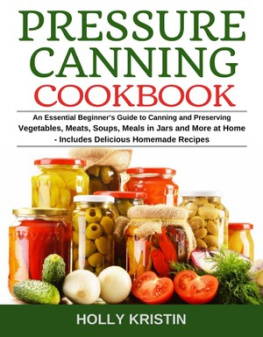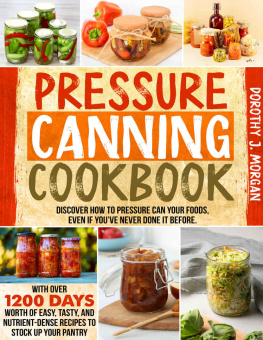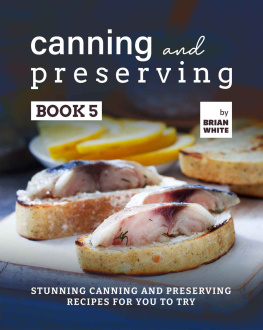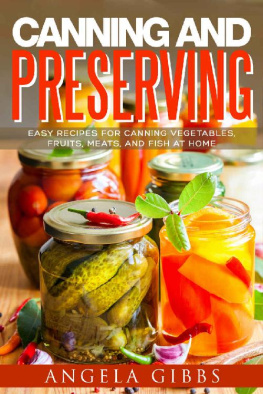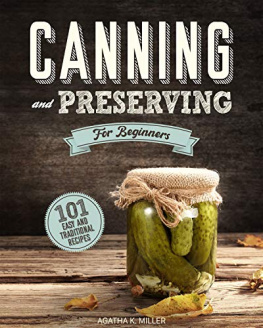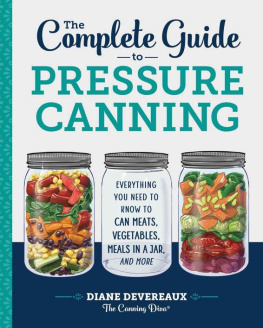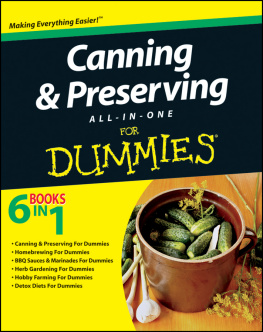PRESSURE CANNING COOKBOOK
Copyright 2020 Holly Kristin
All Rights Reserved. No part of this book may be reproduced or used in any form or by any means without written permission from the author.
TABLE OF CONTENTS
Thank you for the purchase of Pressure Canning Cookbook: An Essential Beginners Guide to Canning and Preserving Vegetables, Meats, Soups, Meals in Jars and More at Home - Includes Delicious Homemade Recipes . This book contains detailed information on pressure canning and preserving your low acid foods.
After planting seeds or seedling, watering, and weeding all summer, it is time to harvest. While a lot of your garden bounty ends up in your dinner dishes, baked into snacks, and eaten fresh as you harvested it, there's usually too much fruits and vegetables remaining. In the end, you may just eat cucumbers at each meal for a lot of days in a row until you begin to feel just like you're a cucumber.
This is when you need to can and preserve your fruits and vegetables. Canning is a great way to store your veggies and fruits while they're in season, and it makes your bounty last throughout winter when seasonal and local food items are rare.
Canning in both pressure and water baths canners heats the food, eliminating any germs that can grow and also makes a vacuum seal inside the jar. The vacuum seal helps to stop air from getting into the conserved food as well as discouraging the growth of cells that could cause food spoilage.
This ultimate guide explains, with easy-to-follow directions, the safe and straightforward process of pressure canning food such as meat, corn, vegetables, tomatoes, stock and so on right in your own kitchen.
Canning became very common and its a secure, healthy, cheap, and relatively straightforward procedure. Individuals were able to use one technique to conserve just about anything - vegetables, fruits, meats, sauces, and soups.
The process of canning is straightforward. First of all, get a glass jar or tin can with food. Once the container has been sealed, it's heated and consistently placed under pressure. This procedure kills any germs that might lead to disease or spoil food. When a can is taken out of the water, the air inside squeezes and seals contents away from the external world. The seal then shields the food from new germs and oxidization from the air. Then, the meals could be easily stored and eaten later.
Strategies for canning foods in the home have changed considerably since the process was initially introduced nearly two centuries ago, studies have allowed home canners to simply and safely conserve higher quality meals. The reasons why canning works and the causes of food spoilage are discussed below:
How Canning Conserves Foods
1. Invisible microbes are around us. Many are valuable; many others are detrimental. All foods include bacteria, the primary source of food spoilage. Appropriate canning methods prevent this spoilage with the use of heat to destroy germs. Throughout the canning process, the air is expelled from the jar, and a vacuum is created as the jar seals and cools, preventing germs from penetrating and re-contaminating the foods.
2. Sufficient sugar (as in jellies and jams) or acid (as in pickled goods and fruits) guards against the development of some microbes. Nevertheless, in low-acid foods, some germs aren't ruined at 212 degrees Fahrenheit. Consequently, low-acid foods must be heated to high temperatures, which may be achieved only with the use of a pressure canner.
3. It doesn't take long at 212 degrees, which is the temperature where water boils, to force out the air, make a vacuum and seal off a jar. It will, however, take a particular quantity of heat for a specific amount of time to kill particular microorganisms. Even though a jar is "sealed," all germs aren't necessarily killed.
4. Low-acid foods like veggies, fish, poultry, and meat should be pressure canned at the recommended temperature and time to kill Clostridium botulinum, which is the bacterium that leads to botulinum food poisoning. The canning of low-acid foods in a boiling water canner is dangerous because 212 degrees F isn't high enough to kill botulinum bacteria. In case the botulinum bacterium survives and grows in a sealed jar, it could create a deadly poison. A taste of food containing this toxin could be toxic.
Food Acidity
The level of acidity or pH in food determines whether such food would be canned in a pressure canner or boiling water canner. This is because the lower the pH, the more acidic the food. Foods with high acid contain pH values below 4.6. Such foods include most fruits, pickles, jellies, and jams - when pickling, the acid level is raised by the addition of vinegar, citric acid or lemon juice. Acidic foods include sufficient acidity to block the growth of botulinum bacteria or kill the germs faster when heated. Acidic foods can be canned safely in a boiling water canner.
The acidic foods comprise fruits and appropriately pickled veggies. Certain foods such as figs and tomatoes, which have a pH value of about 4.6 should have acid added to them to utilize the water bath process. This can be achieved by adding citric acid or lemon juice.
Low-acid foods have pH values greater than 4.6. They don't have adequate acid to avoid the growth of botulinum bacteria. Such foods should be canned at the temperature of 240 degrees Fahrenheit to 250 degrees Fahrenheit, which is achievable with a pressure canner set at 10 to 15 pounds psi (per square inch) of pressure. The precise time is based on the type of food being canned, how it's packed, and the dimensions of the jars used. When you combine high-acid and low-acid foods, then assume the combination remains low-acid. Though tomatoes used to be regarded as acidic food, a few are known to have pH values somewhat above 4.6, which implies they're low-acid.
The low-acidic foods comprise:
All vegetables
Dairy products
Poultry
Seafood
Meats
Adjustment for Altitude to Safeguard a Safe Product
You need to know your altitude when canning even in Ohio. Don't use processing times estimated for canning food at sea level if you stay at an altitude above 1,000 ft. For instance, water boils at a lower temperature when the altitude rises. Lower boiling temperatures aren't effective for destroying bacteria; you have to increase either the canners pressure or processing time to make up for the lower boiling temperature. Use publications according to USDA (United States Department of Agriculture)-approved guidelines to choose the suitable canner pressures and process time for your altitude.
Storing Canned Foods
When your securely sealed, cooled jars are ready to be stored, rinse the jar and lid to eradicate food residue, wash and dry the jars. Then, place label and date on the jars and store in a cool, dark, dry spot. Don't store the jars over 95F or near a furnace, a range, hot pipes, in an uninsulated loft or under direct sunshine. Under conditions such as these, food may spoil or lose quality rapidly. Humidity may rust metal covers, break seals and cause spoilage and contamination. Eat your home-canned foods within a year for optimal quality and nutrient value.
How to Identify and Handle Spoiled Canned Foods
1. Dont taste food that seems to have spoiled or out of an unsealed jar with an opened lid or food. When you are using food jars, check the cap for tightness.
2. Before you open a jar, inspect the contents for unnatural color or increasing gas bubbles. While unsealing the jar, also check for mold growth on the surface of the food and bottom of lid and smell for unnatural odor.
3. Spoiled acidic food must be disposed of in an area where humans or pets won't consume it.

